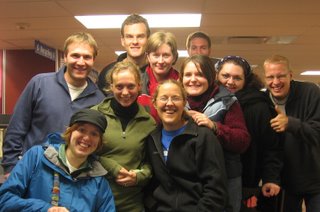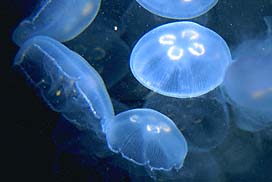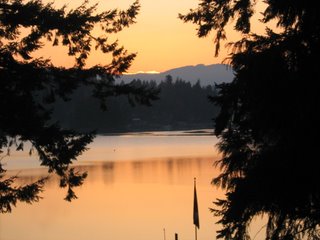 Well, I didn’t find a lot of sunshine on the Sunshine Coast, but I found plenty of other experiences to satisfy me. I had my fill of theological conversation on the car ride there. Upon arriving, I walked a winding path to the top of a hill and spent half and hour watching a red-breasted sapsucker. (A bird.) I learned how to play Rook and lost badly, but was entertained all the while by the trash-talking between my three fellow Canadian card players, Dan, James and Alley. I stayed in a yellow room, looked out at a red Japanese maple tree and navigated deep green waters in a white canoe. I shared tons of laughter and stories and Scripture reading and delicious meals and wine in a hot tub with nine other Regent students. I watched leaves fall. I played the piano for fun. I read a book. I drank hot chocolate with ice cream in it while staring up at shooting stars and listening to Sarah quote G.M. Hopkins.
Well, I didn’t find a lot of sunshine on the Sunshine Coast, but I found plenty of other experiences to satisfy me. I had my fill of theological conversation on the car ride there. Upon arriving, I walked a winding path to the top of a hill and spent half and hour watching a red-breasted sapsucker. (A bird.) I learned how to play Rook and lost badly, but was entertained all the while by the trash-talking between my three fellow Canadian card players, Dan, James and Alley. I stayed in a yellow room, looked out at a red Japanese maple tree and navigated deep green waters in a white canoe. I shared tons of laughter and stories and Scripture reading and delicious meals and wine in a hot tub with nine other Regent students. I watched leaves fall. I played the piano for fun. I read a book. I drank hot chocolate with ice cream in it while staring up at shooting stars and listening to Sarah quote G.M. Hopkins. I think the best part was the water. As I said, it looked forest green, probably because of the reflection off the evergreen-covered mountains. Color alone gave it an aura of mystery, but it had many more secrets. Soon after arriving, Leanne and I set off in a canoe. Only a couple minutes into our trek, Leanne let out a gasp. I followed her gaze over the side of the canoe, and was so astonished and excited I nearly fell in. Aurelia aurita! (Translation: the moon jelly, or common jellyfish.) There was nothing common about them as I saw them for the first time in the wild! The moment was dream-like and surreal; there must have been twenty of them around the canoe, at different depths, all slowly rising. About the size of dinner plates, they seemed to glow fluorescent pink in the dark water, especially the horseshoe-shaped gonads and the peripheral pink fringe, which reminded me of the gathered bottom of window blinds. The glow came from the whole animal, eerily… how can something transparent glow? Upside-down was my favorite view. Its four translucent oral arms drifted lazily in a spiral, and in the center, a strangely lovely ribboned cluster fringed with white light seemed to be the treasure it was protecting under its bell, the secret location of its radiance… (I found these pictures online – I couldn’t take any satisfactory photos of my own!)
I think the best part was the water. As I said, it looked forest green, probably because of the reflection off the evergreen-covered mountains. Color alone gave it an aura of mystery, but it had many more secrets. Soon after arriving, Leanne and I set off in a canoe. Only a couple minutes into our trek, Leanne let out a gasp. I followed her gaze over the side of the canoe, and was so astonished and excited I nearly fell in. Aurelia aurita! (Translation: the moon jelly, or common jellyfish.) There was nothing common about them as I saw them for the first time in the wild! The moment was dream-like and surreal; there must have been twenty of them around the canoe, at different depths, all slowly rising. About the size of dinner plates, they seemed to glow fluorescent pink in the dark water, especially the horseshoe-shaped gonads and the peripheral pink fringe, which reminded me of the gathered bottom of window blinds. The glow came from the whole animal, eerily… how can something transparent glow? Upside-down was my favorite view. Its four translucent oral arms drifted lazily in a spiral, and in the center, a strangely lovely ribboned cluster fringed with white light seemed to be the treasure it was protecting under its bell, the secret location of its radiance… (I found these pictures online – I couldn’t take any satisfactory photos of my own!)

As I observed this beautiful undersea suspended animation, I remembered my only other experience with Aurelia, examining one in a glass dish in Bio 203 (have you done Cnidaria yet, Terice?), turning the dead gelatinous mass (haha, Strongbad) with my tweezers and trying to imagine what it would look like alive in the ocean. My imagination wasn’t near as wonderful as the reality. The process of watching is half the fun. It starts out as a gauzy outline, playing with your depth perception, causing you to look twice – was that just the watery reflection of a small cloud? No, it’s moving!…in slow but determined spurts, rising into greater clarity, growing brighter and larger, sometimes drifting, open and careless, its fringe of tiny hairs floating listlessly, before its muscles contract and it resumes its pulsing motion. It seemed to be deciding where and when to move, which parts of itself to reveal to me, even though it had no brain. (What is it with me and these brainless ocean creatures?) As we circled and circled in our canoe, more and more Aurelia surfaced in this surreal, enthralling way. The scientist in me tried to memorize what it looked like at every angle, tried to remember what all the parts were called. The child in me knew that the water was enchanted, and I was seeing pure magic, whose depth only an ocean-deprived prairie girl could fully appreciate. I am thankful that Leanne shared my delight.

The next morning, I sat on the dock for two hours, stalking the water, trying to see past the surface reflection. I saw many more moon jellies, and my breath caught in my throat every time. At times I would see tiny flashes of light erupt randomly all through the water, which reminded me of the very artificial “sparkle” effect they used to put in movies after something magical happened, like someone disappearing. When my eyes adjusted, I realized it was a school of small fish, with scales catching the sunlight when they happened to be at the right angle. I also saw a burrito-shaped white spiny thing on the bottom that moved very slowly. I think it was a nudibranch, a.k.a. sea cucumber, one of the weirdest things I studied in biology. Again, seeing creatures in the ocean is entirely different from examining them in a biology lab dish.

Since I got home on Wednesday, I’ve been trying to put the “reading” back in Reading Week. I’m marginally satisfied with my productivity, considering the high expectations I had for myself. I had a great morning with the Crazy Boggers yesterday. Instead of pulling bad, invasive things out of the bog, we got the rare pleasure of planting good things in the bog! Both activities are necessary and restorative, but I’ve discovered that it’s more emotionally satisfying to plant than to remove. As I pushed little bunches of sphagnum moss into the wet dirt with my thumb, I found myself silently pleading that God would cause them to grow and spread, and un-do the damage we’ve done to this part of our/His earth. It was deeply satisfying to do this repetitive, dirt-under-the-fingernails work of redemption with the Creator of bogs. God-willing (and God-very-much-helping), the bare ground in that section will once again be covered with sphagnum...but not until about five years from now. It’s weird being part of such long-term work, work that might not even pay off if the weather doesn’t cooperate. I can’t imagine working on those cathedrals in the Middle Ages, knowing the finished product was 150 years off and you’d never see it. (If you for some reason happen to be interested in this bog thing, the website is great – http://www.naturalhistory.bc.ca/CamosunBog/
 As is my custom of late, I leave you with a quote. I read some of Annie Dillard’s “Teaching a Stone to Talk” this week, and this part in particular resonated with many experiences I’ve described above…
As is my custom of late, I leave you with a quote. I read some of Annie Dillard’s “Teaching a Stone to Talk” this week, and this part in particular resonated with many experiences I’ve described above…“The mountains are great stone bells; they clang together like nuns. Who shushed the stars?…Billions of stars sift among each other untouched, too distant even to be moved, heedless as always, hushed. The sea pronounces something, over and over, in a hoarse whisper; I cannot quite make it out. But God knows I have tried.
At a certain point you say to the woods, to the sea, to the mountains, the world, Now I am ready. Now I will stop and be wholly attentive. You empty yourself and wait, listening. After a time you hear it: there is nothing there. There is nothing but those things only, those created objects, discrete, growing or holding, or swaying, being rained on or raining, held, flooding or ebbing, standing, or spread. You feel the world’s word as a tension, a hum, a single chorused note everywhere the same. This is it: this hum is the silence. Nature does utter a peep – just this one. The birds and insects, the meadows and swamps and rivers and stones and mountains and clouds: they all do it; they all don’t do it. There is a vibrancy to the silence, a suppression, as if someone were gagging the world. But you wait, you give your life’s length to listening, and nothing happens. The ice rolls up, the ice rolls back, and still that single note obtains. The tension, or lack of it, is intolerable. The silence is not actually suppression; instead, it is all there is.
We are here to witness. There is nothing else to do with those mute materials we do not need… If we were not here, material events like the passage of seasons would lack even the meager meanings we are able to muster for them. The show would play to an empty house, as do all those falling stars which fall in the daytime. That is why I take walks: to keep an eye on things.”

No comments:
Post a Comment